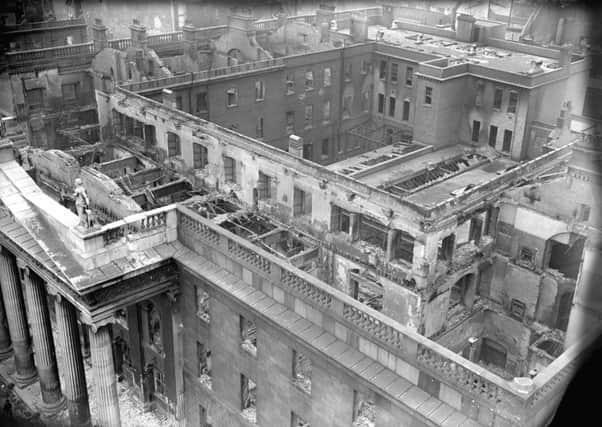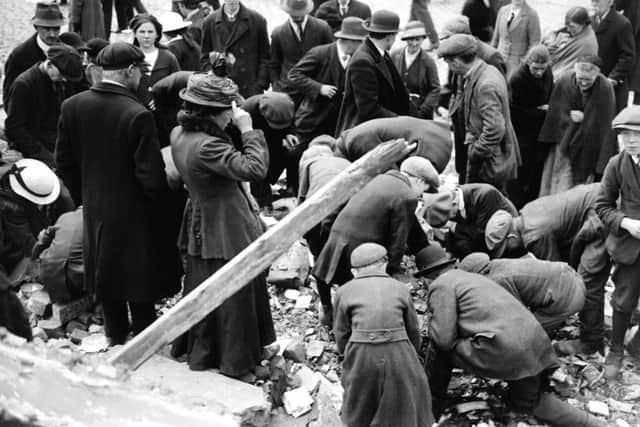There is a new willingness to remember the police who died in the 1916 Rising


Much less is known about 17 other Irishmen who died during the Rising, members of the two domestic police forces, the Royal Irish Constabulary (RIC) and the Dublin Metropolitan Police (DMP).
Fourteen RIC officers were killed during the Rising. The largest number of these died in the most substantial engagement outside Dublin city at Ashbourne, County Meath.
Advertisement
Hide AdAdvertisement
Hide AdThe eight RIC officers who died at Ashbourne were District Inspector Harry Smith, County Inspector Alexander Gray, Sergeants John Young and John Shanaghar and Constables James Cleary, James Gormley, James Hickey and Richard McHale.


In spite of being the site of the most intense fighting, only four policemen died in Dublin City, where the heaviest British casualties were soldiers (who accounted for 26% of the 485 people known to have died in the Rising).
Three of these were members of the unarmed DMP – Constables William Frith, James O’Brien and Michael Lahiff.
The latter died of gunshot wounds widely believed to have been inflicted by Constance Markievicz, who was in command of the Irish Citizen Army outpost at St Stephen’s Green.
Advertisement
Hide AdAdvertisement
Hide AdThe only RIC officer to die in Dublin, Christopher Millar from Belfast, was temporarily based in Dublin and died in a military assault on the rebel post at the South Dublin Union (now St James’s Hospital).


Outside of Dublin City and Ashbourne, the main locations of rebel activity were County Louth near Castlebellingham, East Galway and Enniscorthy, County Wexford. Constables Henry McGee and Patrick Whelan were killed in Louth and Galway but no policemen died in Wexford.
Sergeant Thomas Rourke and Constable John Hurley were shot dead by and Irish Volunteer, Michael O’Callaghan, in an isolated engagement in Kilross, County Tipperary on the Wednesday of Easter Week (26 April), when the police surrounded a house where local Volunteers were meeting.
The only member of the volunteers executed in Ireland but outside Dublin, was Thomas Kent, who in September last year was reburied in his family’s burial plot at Castlelyons and accorded a state funeral by the Irish government.
Advertisement
Hide AdAdvertisement
Hide AdKent was executed for his involvement in the death of RIC Head Constable William Rowe. Rowe’s death occurred after the Rising had ended, on May 2 1916.


The Kents had come under suspicion for their well-known nationalist activities and the police surrounded their farmhouse; in an ensuing exchange of gunfire, Rowe and Richard Kent died.
There is no evidence that Thomas Kent fired the fatal shot and the family later claimed that Richard Kent had done so, though this evidence was produced in the context of the court-martial of another brother David, whose sentence for the killing of Rowe was commuted.
In the aftermath the Rising the Inspector General of the RIC, Neville Chamberlain (not to be confused with the later Prime Minister of the same name), argued that the dependants of the policemen who died should be given an equivalent military rank which would have entitled their families to compensation similar to that of soldiers.
Advertisement
Hide AdAdvertisement
Hide AdWhile this recommendation was rejected by the Irish authorities in Dublin Castle, who feared establishing a precedent, additional compensation in excess of what was provided for in the Constabulary Acts was awarded in most cases.


This reflected a precedent of awarding more generous compensation to the families of Irish policemen who died as a result of political violence that stretched back to the Land War of the 1880s when the widows of police constables killed on duty were given pensions four times in excess of what they were legally entitled to.
In the case of four married RIC officers – Smith, Rowe, Rourke and Young – their widows were given pensions greater that what was provided for by law.
As a District Inspector, Smith was the highest ranking, and his widow received a pension of £100, considerably in excess of the £30 to which she would ordinarily have been entitled. The widows of Rowe, Rourke and Young had their pension entitlement raised from £15 to £50.
Advertisement
Hide AdAdvertisement
Hide AdAll four men left young children – Smith had four, Rowe had five, Rourke had one and Young had two – all under the age of 16.
More generous provisions were also made for them, as well as for four RIC officers (Sergeant Patrick Scully and Constables Patrick Grace, Henry Leckey and Patrick Cunningham) who retired from the force because they were ‘permanently incapacitated’ by the injuries they received.
While the focus of much of this year’s centenary commemoration of the Easter Rising will inevitably be on the actions of the rebels in Dublin city, the memory of these other Irish fatalities is being resurrected.
The RIC and DMP police plots in Glasnevin Cemetery have been restored in recent years. The police who died in the Rising are recognised among the 485 fatalities recorded by Glasnevin’s ‘Necrology of 1916’ project.
Advertisement
Hide AdAdvertisement
Hide AdSome events organised by local communities as part of the Irish government’s 2016 commemorations will also remember these policemen; on 26 April the Mayor of Galway and the Chair of Galway County Council will lay a wreath in Bohermore Cemetery at the grave of Constable Patrick Whelan.
Such events indicate a greater willingness to reflect upon the multi-facted Irish experience of Easter Week 1916 than was the case in previous commemorations.
• Marie Coleman is a Lecturer in Irish History at Queen’s University Belfast. Her books include The Irish Revolution, 1916-1923 (2013)